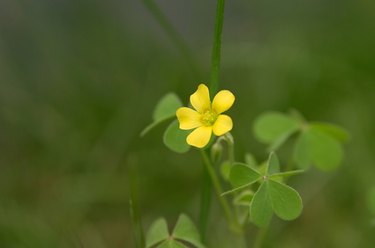
Perhaps the best way to define a weed is as a plant that's growing where it isn't welcome, and on a lawn that's supposed to be solid green, that pretty much includes anything that isn't grass. Lawn weeds with yellow flowers, such as dandelion (Taraxacum officinale, USDA zones 5-9), yellow clover (Melilotus officinalis, zones 4-9) and yellow wood sorrel (Oxalis stricta, zones 3-10), are perhaps the most unwelcome because they stand out so strikingly against a green backdrop, especially on a sunny day. Keep in mind that these plants aren't necessarily detrimental — dandelion has medicinal and nutritional value, and yellow clover is often planted on its own as a ground cover — they just look out of place in a green expanse of lawn.
You're searching for a way to get rid of these interlopers without harming the grass, and fertilizer companies are there to offer an easy solution with weed and feed fertilizer mixtures. Pennington, for example, offers Pennington Ultragreen Weed & Feed 30-0-4, which will dispatch all three of these yellow weeds and more, and you can also use Scotts Turf Builder Weed & Feed to get the same results. Some people may not want to layer the lawn with herbicides for several good reasons, however, and for them, there are other strategies.
Video of the Day
Video of the Day
Using Weed and Feed
Weed-and-feed products typically contain a nitrogen-rich mixture of grass fertilizer and selective herbicides for broadleaf plants. The nitrogen is usually in a quick-release form, which means it soon disperses in the soil and needs replenishing, so you have to fertilize more than once in the season to maintain a green lawn. But this two-in-one product isn't always the best course of action because the optimal timing for applying a pre-emergent herbicide and fertilizer isn't always concurrent.
If you do use a weed-and-feed product, spread the mixture with a drop spreader or broadcast spreader, following the manufacturer's instructions on the product label to ensure you don't spread too much and burn the grass. The herbicide, like the fertilizer, is in granular form and will settle on the foliage of broadleaf weeds, from where the plants absorb it and die.
Alternatives to Weed and Feed
Among the several good reasons for not using weed and feed are that the herbicide is harmful to birds that consume it, and it pollutes the groundwater and could end up in the food chain. One of the safest approaches to weed control is manual removal — you know, going out there and weeding the lawn. It might not be as big a job as you think, especially if you have a quality weed-pulling tool. Extracting weeds from the ground by the roots is the most effective way to ensure they won't grow back.
How to Prevent Weeds
The best offense is good defense, so if you take steps to keep weeds under control, you'll never have to get rid of them. Weeds tend to grow in compacted, acidic soil, so if a soil test indicates low pH, consider spreading lime to raise it and aerate the soil to loosen and oxygenate it. Just make sure not to raise the pH so much that your turfgrass suffers. Mowing the grass high also helps control weeds by encouraging the grass to develop stronger roots. Finally, consider reducing watering to just enough to keep the grass healthy, thereby depriving weeds of the moisture they need.
- RichSoil.com: Organic Lawn Care for the Cheap and Lazy
- Gardening Channel: Getting Rid of Lawn Weeds
- Pennington: Common Lawn Weeds and How to Get Rid of Them
- OARDC Ohio Perennial and Biennial Weed Guide: Dandelion (Taraxacum officinale)
- Midwest Invasive Species Information Network: Yellow Sweet Clover (Melilotus officinalis)
- Lady Bird Wildflower Center: Oxalis stricta